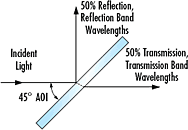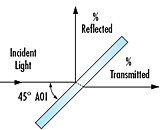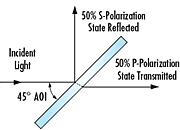
A plate beamsplitter is the most common type of beamsplitter. It features a thin glass substrate. The reflective coating is typically optimized at 45°, and an anti-reflection coating is commonly applied to the rear surface. Similar to cube beamsplitters, plate beamplitters also come in polarizing and non-polarizing types. Polarizing plate beamplitters split the input beam into two orthogonal components; P-polarized light is transmitted while S-polarized light is reflected 90° to it. Non-polarizing plate beamsplitters split the input beam into two orthogonal components; average, P-polarized and S-polarized states are transmitted and reflected equally. Dichroic plate beamsplitters reflect one portion of the spectrum while transmitting the other. They are ideal for splitting or combining specific wavelengths of light, depending upon the application setup. Polka-dot plate beamsplitters offer specific reflection/ transmission ratios. They have a constant reflection-to-transmission ratio over a large spectral range, making them ideal for use from UV to mid-IR. They are also not angle sensitive so they are great for splitting energy from a radiant light source. Pellicle beamsplitters offer specific reflection/ transmission ratios as well. Due to their ultra-thin nitrocellulose membrane construction, there are no ghost images from second surface reflections, no chromatic aberration with converging beams, and no change in optical path length. Elliptical plate beamsplitters maximize beamsplitter efficiency while maintaining required mounting space. When oriented at 45° they create a circular aperture equal to the diameter of the minor axis.
| Polarizing | Non-Polarizing | Lateral Displacement |
|---|---|---|
 |
 |
 |
或查看各区域电话
报价工具
只需输入商品编号
Copyright 2023, 爱特蒙特光学(深圳)有限公司。— 广东省深圳市龙华工业东路利金城科技工业园3栋5楼 518109 - 粤ICP备2021068591号